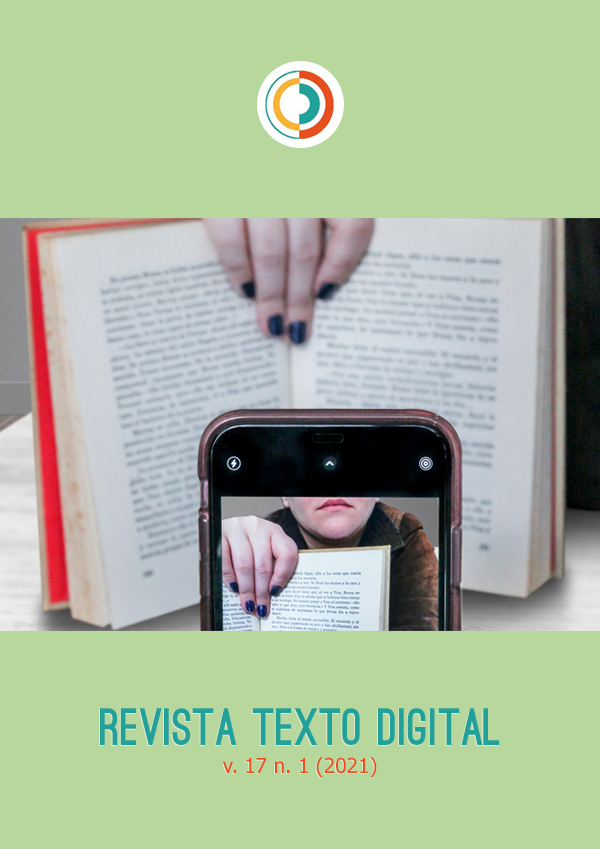Multimodalidade e livros de Realidade Aumentada (RA) para crianças: uma análise da obra literária “Mur”
DOI:
https://doi.org/10.5007/1807-9288.2021.e81171Resumo
O objetivo deste artigo é analisar o livro ilustrado de Realidade Aumentada (RA) para crianças Mur, das finlandesas Kaisa Happonen e Anne Vasko, com base na teoria da multimodalidade. A proposta é descrever os meios e modos utilizados na construção dessa obra e, em seguida, responder como eles se articulam para produzir sentidos e efeitos estéticos integrados. Após uma breve introdução sobre a Realidade Aumentada e sobre a obra, há uma reflexão sobre o campo de estudos da multimodalidade, com ênfase em seus principais conceitos operacionais: recursos semióticos, meios e modos. Na seção seguinte, por sua vez, esses conceitos são mobilizados para compreender como os recursos tecnológicos usados para gerar a experiência da Realidade Aumentada na obra Mur serviram para potencializar os seus efeitos estéticos. Nessa mesma seção, são abordados dois principais meios da obra: a imagem e a escrita. Por fim, na conclusão, há uma reflexão sobre como os modos e os meios se articulam nessa obra para produzir uma experiência de leitura significativa.
Referências
AARSETH, Espen J. Cybertext: Perspectives on Ergodig Literature. Baltimore & London: John Hopkins, 1997.
AKHTAR, Omar. Understanding Use Cases for Augmented, Mixed and Virtual Reality. Research Report Altimeter, 2018.
CORRERO, Cristina; GIL, M. Rosa; JUAN, Anna; REAL, Neus. Juego, lengua y literatura: de la oralidad a la multimodalidade. In: EDO, Mequè; BLANCH, Sílvia; ANTON, Montserrat (eds.). El juego en la primera infância. Barcelona: Ediciones OCTAEDRO, S.L., 2016, p. 113-130
BATEMAN, John; WILDFEUER, Janina; HIIPPALA, Tuomo. Multimodality: A Problem-Oriented Introduction - Foundations, Research and Analysis. Berlin/Boston: Walter de Gruyter GmbH, 2017.
BELMIRO, Celia Abicalil. A multimodalidade na literatura infantil e a formação de professores leitores. RBLA, Belo Horizonte, v. 10, n. 2, 2010, p. 403-420.
BERRY, Rodney; WYSE, Lonce. The Music Table Revisited. Problems of Changing Levels of Detail and Abstraction in a Tangible Representation. In: O’HALLORAN, Kay L.; SMITH, Bradley A.. Multimodal Studies: Exploring Issues and Domains. London & New York, 2011, p. 76-94.
CRAIG, Alan B. Understanding Augmented Reality: Concepts and Applications. Elsevier Inc. Morgan Kaufmann, 2013. (e-book)
FREDERICO, Aline. Lendo um aplicativo: dimensões da construção de sentido na leitura literária digital na primeira infância. PERSPECTIVA, Florianópolis, v. 39, n. 1, jan./mar. 2021, p. 1-25.
GRANSTRÖM, B.; HOUSE, D.; KARLSSON, I. (eds). Mutlimodality in language and speech systems. Kluwer Academic Publishers, Dordrecht, 2002.
GREIMAS, Algirdas Julien; COURTÉS, Joseph. Dicionário de semiótica. São Paulo: Contexto, 2008.
HAMER, Naomi. The Design and Development of the Picture Book for Mobile and Interactive Platforms: ‘You get to BE Harold’s Purple Crayon’. In: HAMER, Naomi; NODELMAN, Perry; REIMER, Mavis (eds.) More Words about Pictures: Current Research on Picture Books and Visual/Verbal Texts for Young People. London & New York: Routledge, 2017, p. 63-80.
HAPPONEN, Kaisa; VASKO, Anne. L’orsetta Mur. Milão: D’Agostini, 2018. App desenvolvido pela STEP IN BOOKS, 2017.
HERMAN, David. Word-Image/Utterance-Gesture Case Studies in Multimodal Storytelling. In: PAGE, Ruth. New Perspectives on Narrative and Multimodality. London & New York, Routledge: 2010, p. 78-98
HERMAN, David; PAGE, Ruth. Coda/Prelude - Eighteen Questions for the Study of Narrative and Multimodality. In: PAGE, Ruth. New Perspectives on Narrative and Multimodality. London & New York: Routledge, 2010, p. 217-220.
JEWITT, Carey; BEZEMER, Jeff; O’HALLORAN, Kay. Introducing multimodality. Routledge: London & New York, 2016.
KALANTZIS, Mary; COPE, Bill; CHAN, Eveline; DALLEY-TRIM, Leanne. Literacies. Cambridge: University Press, 2016.
KOIE, Aksel. A Bear Called Mur: An Interview with Aksel Koie. Jun, 13, 2017. Disponível em: https://newbooksnetwork.com/interview-with-aksel-koie-ceo-of-step-in-books/. Último acesso em 05/05/2021.
KRESS, Gunther. Multimodality: a social semiotic approach to contemporary communication. London & New York: Routledge, 2010.
KRESS, Gunther. What is mode? In: JEWITT, Carey (ed.) The Routledge Handbook of multimodal analysis’. 2º ed. London & New York: Routledge, 2014, p. 60–75.
KRESS, Gunther; van LEEUWEN, Theo. Reading Images: The Grammar of Visual Design. (2º ed.) London & New York: Routledge, 2006.
KRESS, Gunther; van LEEUWEN, Theo. Multimodal Discourse: The Modes and Media of Contemporary Communication. London: Bloomsbury, 2001.
NIKOLAJEVA, Maria. The Verbal and Visual: The Picturebook as a Medium. In: SELL, Roger D. (ed.) Children’s Literature as Communication: The ChiLPA Project. Amsterdam: John Benjamins, 2002, p. 85–108.
TOOLAN, Michael. Electronic Multimodal Narratives and Literary Form. In: PAGE, Ruth (Ed.). New Perspectives on Narrative and Multimodality. London & New York, Routledge, 2010, p. 127-141.
WIGNELL, Peter. Picture Books for Young Children of Different Ages: The Changing Relationships between Images and Words. In: O’HALLORAN, Kay L.; SMITH, Bradley A.. Multimodal Studies: Exploring Issues and Domains. London & New York, 2011, p. 202-219
VIEIRA, Josenia; SILVESTRE, Carminda. Introdução à Multimodalidade: Contribuições da Gramática Sistêmico-Funcional, Análise de Discurso Crítica, Semiótica Social. Brasília, DF: J. Antunes Vieira, 2015.
Downloads
Publicado
Edição
Seção
Licença
Copyright (c) 2021 Edgar Roberto Kirchof

Este trabalho está licenciado sob uma licença Creative Commons Attribution 4.0 International License.
Autores que publicam nesta revista concordam com os seguintes termos:
- Autores mantém os direitos autorais e concedem à revista o direito de primeira publicação, com o trabalho simultaneamente licenciado sob a Licença Creative Commons - Atribuição 4.0 Internacional que permite o compartilhamento do trabalho com reconhecimento da autoria e publicação inicial nesta revista.
- A licença Creative Commons - Atribuição 4.0 Internacional permite a cópia e a redistribuição do material em qualquer suporte ou formato, assim como adaptações, para quaisquer fins, inclusive comerciais.
- Autores têm autorização para assumir contratos adicionais separadamente, para distribuição não-exclusiva da versão do trabalho publicada nesta revista (ex.: publicar em repositório institucional ou como capítulo de livro), com reconhecimento de autoria e publicação inicial nesta revista.



